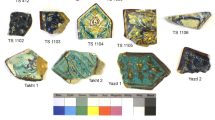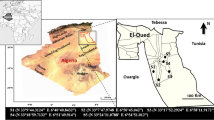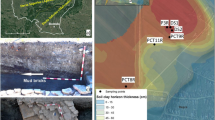Abstract
Šarišša is one of the most important cities of Hittite Empire in the range of 16th–twelfth century BCE. The city’s importance comes from being the Empire’s summer palace as well as castle formation is seen around the city which gives the Turkish name “Kuşakli” means “Surrounded-Belted” in English. Šarišša is said to be destroyed by a fire/incendiary or battle and almost all mudbricks were given fire and their initial structures were deformed. The fired form of these ceramics could not be identified due to different degrees of fired ceramics and their identification may also favor the provenance analysis of the region’s soil structure that is suitable for the production of mudbricks. For the analysis of mudbricks, X-ray fluorescence (XRF) analysis was evaluated first to understand the principal, compound former, and trace oxides to compare with geological soil formation and rock types. By examining XRF, the oxides were characterized for compound formation even for mineral composition. As evaluated, main oxides are SiO2, CaO, Fe2O3, Al2O3, MgO, and K2O; compound former was the volatile SO3 that has the formation possibility of gypsum as Sivas’s most provenance soil type within illite-muscovite type clays. Besides, scanning electron microscopy (SEM) and energy dispersive spectroscopy (EDX) analysis were briefly evaluated and the firing temperatures were estimated. From SEM images and EDX analysis, a very good match with XRF analysis was found by means of elemental distribution and especially Na amount was approached as glassifier by sintering of materials in the range of 800 and 1200 °C due to the glassification, vitrification, sulfate removal, and low viscosity bubble formation due to glass melting.








Similar content being viewed by others
References
Müller-Karpe, A.: Kuşakli-Šarišša Yukari Ülke’de Bir Kült Merkezi. Maşathöyük Kaška Sinir Bölgesinde Bir idare Merkezi. Hititler ve Hitit İmparatorluğu Bin Tanrili Halk. Kunst-und Ausstellungshalle der Bundesrepublik Deutschland, Bonn (2002)
Müller-Karpe, A.: Yeni Bir Hitit Merkezi: Kuşakli (Başören/Sivas) 1992 Yili Yüzey Araştirmasi. XI. AST, 259–264 (1994)
Boehmer, R.M.: “Havuzkoy in Ostkappadokien.” AA 82. 1967: 132–41. Orthmann. W. Untersuchungen zur späthethitischen Kunst. Bonn (1971)
von der Osten, H.H.: Explorations in Hittite Asia Minor 1927-28, pp. 69–73. OIC 6, Chicago (1929)
Engin, A.: “Gözecik: Sivas’da Yeni Bir Geç Hitit Merkezi ve Kapi Aslani”. C.Ü. Sosyal Bilimler Dergisi. Aralik 2010. Cilt: 34. Sayi: 2. 60-68
Müller-Karpe, A.: The rise and fall of the Hittite Empire in the light of dendroarchaeological research. In: Manning, S.W., Bruce, M.J. (eds.) Tree-rings and old world archaeology and environment: papers presented in honor of Peter Ian Kuniholm, pp. 1–9. Oxbow Books, Oxford (2009)
Müller-Karpe, A.: “Planning a sacred landscape examples from Šarišša and a Hattusa”. Sacred landscapes of Hitittes and Luwians proceedings of the international conference in honour of Franca Pecchioli Daddi Florence. February 6th-8th 2014. ed. Anacleto D’agostino. Valentina Orsi. Giulia Torri. Firenze University Press. 83–93 (2015)
Atila, N.: Hititlerde Kentsel Yapi: Hattusa. Sapinuva. Šarišša. Tapikka ve Alacahöyük. Gazi Üniversitesi Sosyal Bilimler Enstitüsü Doktora Tezi, Ankara (2018)
Müller-Karpe, A.: Untersuchungen in Kuşakli 1998. MDOG 131, 57–113 (1999)
https://mgm.gov.tr/veridegerlendirme/il-ve-ilceler-statistik.aspx?k=undefined&m=SIVAS. Accessed 23 May 2021
Karadeli, L.: Yeni Bir Hitit Kenti: Kuşakli – Šarišša. Adnan Menderes Üniversitesi Sosyal Bilimler Enstitüsü Yüksek Lisans Tezi, Aydin (2016)
Müller-Karpe, A.: Untersuchungen in Kuşakli 2002. MDOG 136, 103–135 (2004)
Müller-Karpe, A., ve Müller-Karpe, V.: Kusakli-Šarišša. Arkeoatlas. 266- 267 (2011)
Bayazit, M., Işik, İ., Kozbe, G., Güngör., A., İssi, A.: Investigation of a diagnostic group of Bronze Age pottery (Dark Rimmed Orange Bowl ware) from the upper Tigris Valley, Turkey. X-Ray Spectrom. 1–18 (2021)
Oudbashi, O., Hessari, M.: A “Western” imported technology: an analytical study of the Achaemenid Egyptian blue objects. J. Cult. Herit. 47, 246–256 (2021)
Santos, H.C., Caliri, C., Pappalardo, L., Romano, F.P., Rizzo, F.: MA-XRF and XRD analysis revealing a polychrome Centuripe vase. J. Archaeol. Sci. Rep. 35, 102760 (2021)
Akyuz, S., Akyuz, T., Kurap, G., Basaran, S., Ucar-Cakan, B., Kocabas, I.: Archaeometric investigations of terra-cotta sarcophages from the excavations at ainos (Enez) Turkey: an EDXRF study. Asian J. Chem. 23(7), 3235–3239 (2011)
Akyol, A.A., Kaduiglu, Y.K.: Restoration studies on Phaselis Hadrian Gate (Kemer, Antalya) through archaeometry. Mediter. Archaeol. Archaeom. 13(1), 89–105 (2013)
Fiorentino, S., Chinni, T., Vandini, M.: Ravenna, its mosaics and the contribution of archaeometry. A systematic reassessment on literature data related to glass tesserae and new considerations. J. Cult. Herit. 46, 335–349 (2020)
Dey, T., Carter, J.C., Swift, K.: SEM-EDX and FTIR analysis of archaeological ceramic potteries from southern Italy. Microscopy 69(6), 371–380 (2020)
İssi, A., Özçatal, M., Kara, A., Alp, A.O.: Production technology and provenance study of brittle wares belonging to the late roman period from Harabebezikan/Turkey. Ceram. Int. 43(2), 2182–2187 (2017)
Luke, C., Roosevelt, C.H., Cobb, P.J., Çilingiroʇlu, C.: Composing communities: chalcolithic through Iron Age survey ceramics in the Marmara Lake basin, western Turkey. J. Field Archaeol. 40(4), 428–449 (2015)
Acknowledgements
The authors would like to express their great attitude to Mr. Ali Alkan, Manager of Sivas Archaeology Museum, for being together as well as his help on friendship approach to us for collecting materials by giving co-signed permission for the Šarišša trip with Mr. Teoman Karaca, Manager of Cultural and Tourism of Sivas City. A part of this study was also conducted in Sivas Cumhuriyet University, Advanced Technology Research and Application Center (CUTAM), in SEM Facility, was also greatly appreciated.
Author information
Authors and Affiliations
Corresponding author
Additional information
Publisher’s note
Springer Nature remains neutral with regard to jurisdictional claims in published maps and institutional affiliations.
Rights and permissions
About this article
Cite this article
Pehlivan, E., Özer, S.A., Pehlivan, G.F. et al. First-time evaluation and characterization of “Šarišša” mudbrick ceramics and findings by SEM–EDX and XRF: chasing the traces of fire. J Aust Ceram Soc 58, 49–62 (2022). https://doi.org/10.1007/s41779-021-00668-0
Received:
Revised:
Accepted:
Published:
Issue Date:
DOI: https://doi.org/10.1007/s41779-021-00668-0




